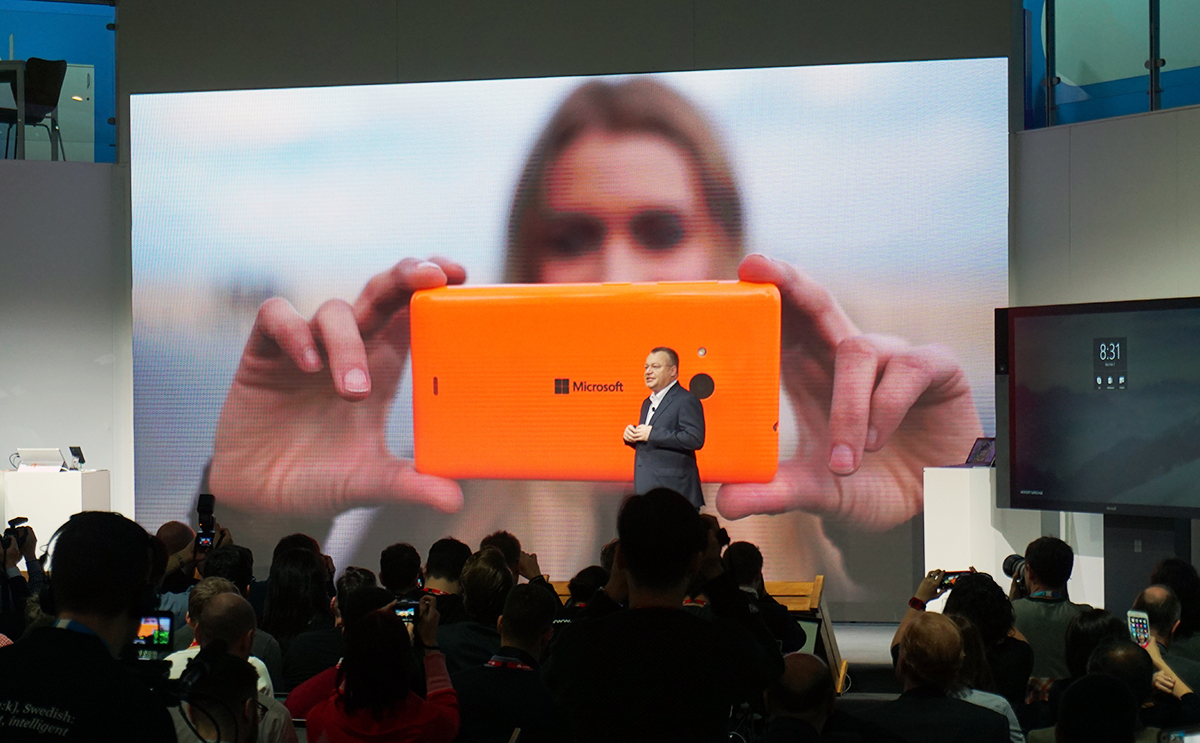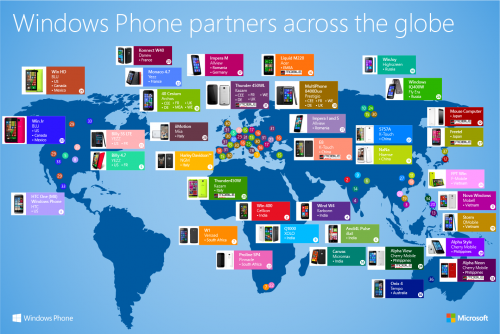Understanding Microsoft's Global, Low-End Windows Phone Strategy
It's no secret that Microsoft has not done particularly well in the smartphone space, where market share is controlled by the entrenched and popular iOS and a massive number of Android phones.
There really isn't even a new flagship Windows Phone device out right now; at MWC 2015, the difference between the phone launches of the high-end HTC One M9, Samsung Galaxy S 6 and Galaxy S 6 Edge, and LG G Flex 2 stood in stark contrast to Microsoft's unveiling of the midrange Lumia 640 and 640 XL.
On the surface, Microsoft appears to be doing all the wrong things here, but the company has a master plan for tackling the mobile market, and it has little to do with high-end flagship devices.
Going Global
"We look at the global smartphone market, and a lot of where we see the market growing faster is aligned very well with where Windows want to play," said Peter Han, Microsoft's VP of Worldwide OEM Marketing at a meeting with us in Barcelona. "We look at emerging markets, breadth players, open channel, local kings -- these OEMs that may not have global brands but have apps and services that are very well tailored to populations in specific countries or areas."
"That's the kind of custom experience we're well-equipped to deliver on the Windows platform," he added.
At the show, 30 phones made by 25 OEMs launched with Windows Phone; there was Acer's Liquid M220, sure, but most of those SKUs are from those aforementioned smaller, local players.
That demographic suits Han's mindset just fine, though. "Windows is an upstart ecosystem," he said. "We're coming from a challenger position with that startup mindset."
Get Tom's Hardware's best news and in-depth reviews, straight to your inbox.
Han said that these smaller players are interested in the Windows Phone platform for multiple reasons. He pointed to the trust those OEMs may have in the Windows brand, as well as "the standardization, the security, [and] the trust of Windows."
Han also noted that Microsoft can offer a great deal of value with apps such as Office. It is, of course, available on multiple platforms, but Han pointed out that Office's integration with the Windows OS is much deeper than, say, Android.
Indeed, Microsoft's press conference announcing the new Lumia 640 and 640 XL phones bore that part of things out. Among the several mini demos Microsoft showed, one that stuck out to me was when we saw how, with the upcoming spate of Universal Apps for Office in Windows 10, you can edit, notate and add comments to an email message with traditional Office features such as Track Changes.
Han also said that some of those local OEMs see Windows as a way to stand out in a market saturated by Android devices.
Free As In Beer?
The whole proposition is made much easier to swallow, however, because of the price of admission. "In line with our current 'underdog' status, we're offering an incredible amount of flexiblity: zero-royalty Windows," said Han. "We're giving them an OS that historically has commanded significant royalties for free." Microsoft sees that freedom as an opportunity for vendors to innovate.
If the OS is free, in contrast to the old method of charging royalties, the value for Microsoft here is in the long game. Instead of shaking a lot of pennies out of the piggy bank, as Han called it, Microsoft needs to gobble up some market share in the short term, and fast. "We're certainly thinking different," Han deadpanned (but we still caught the pun).
Really, this is vertical integration, and that is most definitely part of Microsoft's master plan; it wants users engaged with its OS on their mobile device, tablet, PC, and so on. And there will be a new flagship Windows Phone device coming from Microsoft at some point in the not-too-distant future.
However, Microsoft is also eyeing a more horizontal market with its applications and services loaded onto other devices, such as the iPhone.
Further, the market share situation outside of the U.S. isn't nearly as thin. Han revealed that Windows Phone has double-digit market share in several large countries, including the UK, Italy, France, Germany, Mexico and India.
"Outside of those markets, we absolutely realize that we're an underdog," Han admitted. Further, Microsoft has not given up on North America, although it sounds as if it will pound away at those lower-priced devices, with smaller OEMs that sell in the U.S., such as Blu.
Microsoft needs to continue to gain traction in the smartphone market, but it seems to be finding it outside of the U.S. at these lower price points, and with an unlikely cast of OEMs.
Follow Seth Colaner @SethColaner. Follow us @tomshardware, on Facebook and on Google+.
Seth Colaner previously served as News Director at Tom's Hardware. He covered technology news, focusing on keyboards, virtual reality, and wearables.
-
turkey3_scratch This sounds like dai-jaa-vou (however you spell it) to me:Reply
" it wants users engaged with its OS on their mobile device, tablet, PC, and so on."
How is this any different than what they did with their Windows 8 phones? They are really reattempting to do the same thing, a device-globalized operating system. Let's face it, a phone can not run half the stuff the desktop operating system can, and the apps such as Office and typically boggled-down. I think Microsoft should take a new approach rather than the "Windows on all devices" again, as it didn't work the first time so why go again? -
Martell1977 TBH, flag-ship phones get the most press and if people can't afford a high end phone, they look for cheaper models. I went to AT&T the other day and there were a total of 2 Windows Phones there, everything else was Android or Apple. The store was busy (about 30 people there) and no one was even looking at the Windows phones.Reply
If you don't have a buzz worthy flag-ship phone, no one will pay attention to low end phones. High end phones grab peoples interest and the mid to low end phones are there to fit various budget ranges. I actually have a Lumia 822 and was looking for an upgrade, which from what Verizon and AT&T have to offer, that upgrade doesn't exist. When my contract comes up, I am pretty much forced onto Android due to lack of options. -
aaronmark017 Its true they don't have flagships now. But Lumia Icon (verizon) and Lumia 1520 (AT&T) still are two great options. You can buy them from amazon for a short until they release flagship and you can go off-contract for few days and I know AT&T give discount for going off-contract. And I totally agree that fact that even though flagship does not give much profit (at least for windows phone) but these are great for attention grabber which would eventually increase sell of lower end device. One more thing for some weird reason in US people don't prefer to try new things and so it is tough to convince to windows phone those who are apple or samsung users (may 80 % of them) but for emerging markets a lot of people will be the first time smartphone users and budget is a big deal for them. And I pretty sure Lumia can deliver a great experience in terms prices, and thus they want to grow. Once they have good market share then more developers will come to it, and it will increase sale in US or other developed countries. I think this is what MSFT is thinkingReply -
virtualban And still users only want the same interface with no learning curve, and an up-to-date hard/soft backing system, but MS has still wax on their ears.Reply -
jankeke @turkey3_scratchReply
"This sounds like dai-jaa-vou (however you spell it) to me:"
Déjà vu. It means "already seen" in french. -
CaedenV You are so wrong. MS does not have a 'low end strategy' unless you count running with plan C (or is it Z?) as 'strategy'.Reply
Right now MS is suffering from it's purchase of Nokia. Nokia pretty much gave up in the last year or so of it's existence, and the crap quality of it's devices and the limited reach of it's higher end offerings really shows that out. The phone production cycle is ~18 months from paper to release, so pretty much everything we have seen MS launch so far is still running largely on Nokia's pipeline, not Microsoft's
Secondly, Nokia had some pretty neat devices in the pipeline set for release last fall in the McLauren devices. These devices had a screen sensor that could detect things like a finger hovering above the glass which could be used to trigger drop-down menus and mouse-like use and gestures. Sadly this technology was not ready for the devices, and the rest of the hardware was not differentiated enough from the current flagships (930/Icon and 1520), so MS killed the devices shortly after the Nokia purchase.
MS is not a stupid company. They are well aware that they need a flagship device or two. They intended to release one as an aspirational device that would get people's attention, which would then push their lower end volume devices. But it was a call between launching a flagship that nobody was going to be thrilled with which would damage their brand, vs holding out until MS's own production lineup was able to be put into place and 'doing things right'.
Personally I think that they made the wrong call. The Icon/930 was not accepted (or generally available) as a replacement for the 92x lineup, and releasing some kind of 935 device that was a little slimmer and had features that we have been asking for of the 930 would have really shown a lot of good-will among WP fans. Even if it was just a minor refresh and didn't have the new finger sensing tech, it would have sold more units and would have been a device that their marketing department and fans could have gotten behind. But instead they are treating it like it never happened, claiming that they are just focusing on devices for 'the next billion' users that the next billion are not particularly interested in.
That being said, MS does have a flagship (and probably 2) in the lineup for release 'with Windows 10' which is expected 'this summer' which will hopefully stem the bleeding and start winning mind-share back. Hopefully it is not too little too late, but with any luck we will see MS make a comeback. -
dikfitzwell i'm left handed i lost my other hand in a bike wreck so what about people left handed do we not matter to logitec?Reply -
aldaia Windows phone may still survive in a few selected countries, however, global market share is around 3%, which is close to dead. IOS was as low as 12% but thanks to iPhone 6 climbed to 20% in Q4 2014. While, 3% of the low end market means absolutely nothing, 10-20% of the top premium market is flooding Apple with money.Reply
Isn't it ironic that Microsoft has to give windows phone for free, while it gets several billions from Android patent royalties?
-
Merry_Blind @turkey3__scratchReply
It's "déjà vu" just so you know. It's French. Literally means "already seen".


